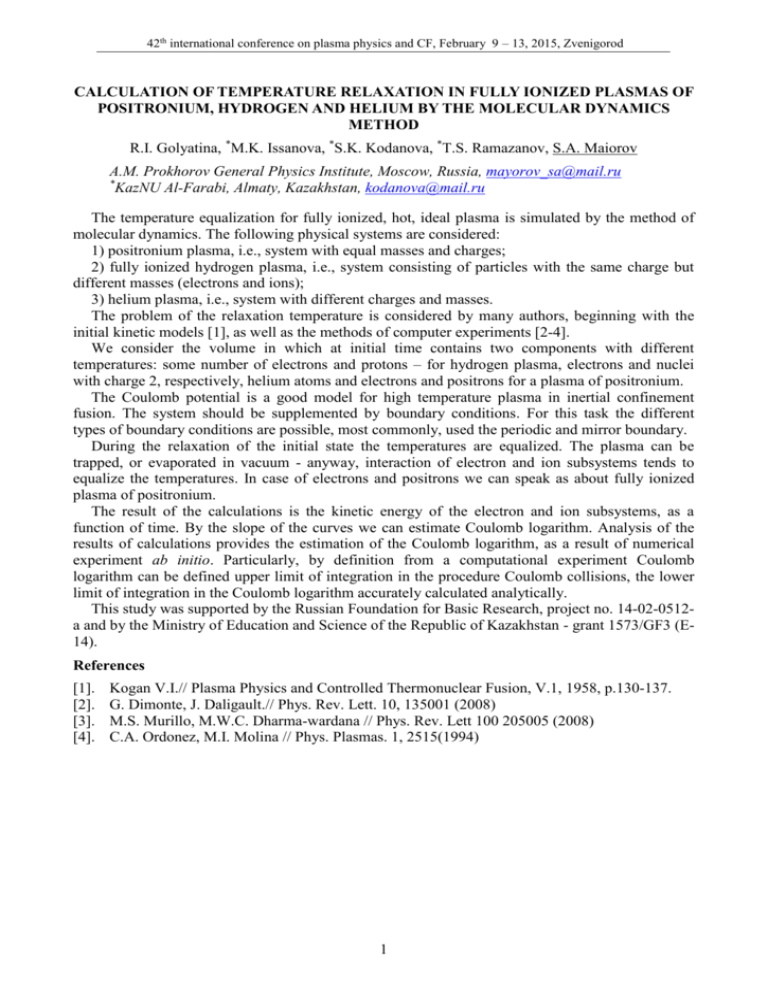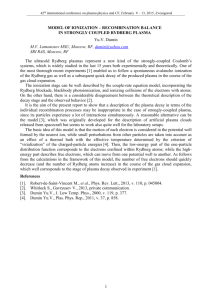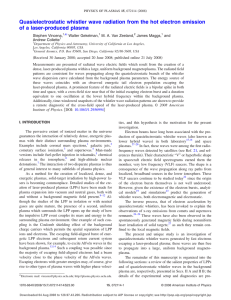calculation of temperature relaxation in fully ionized plasmas of
advertisement

42th international conference on plasma physics and CF, February 9 – 13, 2015, Zvenigorod CALCULATION OF TEMPERATURE RELAXATION IN FULLY IONIZED PLASMAS OF POSITRONIUM, HYDROGEN AND HELIUM BY THE MOLECULAR DYNAMICS METHOD R.I. Golyatina, *M.K. Issanova, *S.K. Kodanova, *T.S. Ramazanov, S.A. Maiorov A.M. Prokhorov General Physics Institute, Moscow, Russia, mayorov_sa@mail.ru * KazNU Al-Farabi, Almaty, Kazakhstan, kodanova@mail.ru The temperature equalization for fully ionized, hot, ideal plasma is simulated by the method of molecular dynamics. The following physical systems are considered: 1) positronium plasma, i.e., system with equal masses and charges; 2) fully ionized hydrogen plasma, i.e., system consisting of particles with the same charge but different masses (electrons and ions); 3) helium plasma, i.e., system with different charges and masses. The problem of the relaxation temperature is considered by many authors, beginning with the initial kinetic models [1], as well as the methods of computer experiments [2-4]. We consider the volume in which at initial time contains two components with different temperatures: some number of electrons and protons – for hydrogen plasma, electrons and nuclei with charge 2, respectively, helium atoms and electrons and positrons for a plasma of positronium. The Coulomb potential is a good model for high temperature plasma in inertial confinement fusion. The system should be supplemented by boundary conditions. For this task the different types of boundary conditions are possible, most commonly, used the periodic and mirror boundary. During the relaxation of the initial state the temperatures are equalized. The plasma can be trapped, or evaporated in vacuum - anyway, interaction of electron and ion subsystems tends to equalize the temperatures. In case of electrons and positrons we can speak as about fully ionized plasma of positronium. The result of the calculations is the kinetic energy of the electron and ion subsystems, as a function of time. By the slope of the curves we can estimate Coulomb logarithm. Analysis of the results of calculations provides the estimation of the Coulomb logarithm, as a result of numerical experiment ab initio. Particularly, by definition from a computational experiment Coulomb logarithm can be defined upper limit of integration in the procedure Coulomb collisions, the lower limit of integration in the Coulomb logarithm accurately calculated analytically. This study was supported by the Russian Foundation for Basic Research, project no. 14-02-0512a and by the Ministry of Education and Science of the Republic of Kazakhstan - grant 1573/GF3 (E14). References [1]. [2]. [3]. [4]. Kogan V.I.// Plasma Physics and Controlled Thermonuclear Fusion, V.1, 1958, p.130-137. G. Dimonte, J. Daligault.// Phys. Rev. Lett. 10, 135001 (2008) M.S. Murillo, M.W.C. Dharma-wardana // Phys. Rev. Lett 100 205005 (2008) C.A. Ordonez, M.I. Molina // Phys. Plasmas. 1, 2515(1994) 1







